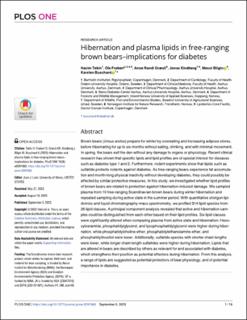| dc.contributor.author | Tekin, Hasim | |
| dc.contributor.author | Frøbert, Ole | |
| dc.contributor.author | Græsli, Anne Randi | |
| dc.contributor.author | Kindberg, Jonas | |
| dc.contributor.author | Bilgin, Mesut | |
| dc.contributor.author | Buschard, Karsten | |
| dc.date.accessioned | 2024-01-15T09:15:52Z | |
| dc.date.available | 2024-01-15T09:15:52Z | |
| dc.date.created | 2023-09-15T12:41:30Z | |
| dc.date.issued | 2023 | |
| dc.identifier.citation | PLOS ONE. 2023, 18 (9), e0291063. | en_US |
| dc.identifier.issn | 1932-6203 | |
| dc.identifier.uri | https://hdl.handle.net/11250/3111434 | |
| dc.description.abstract | Brown bears (Ursus arctos) prepare for winter by overeating and increasing adipose stores, before hibernating for up to six months without eating, drinking, and with minimal movement. In spring, the bears exit the den without any damage to organs or physiology. Recent clinical research has shown that specific lipids and lipid profiles are of special interest for diseases such as diabetes type 1 and 2. Furthermore, rodent experiments show that lipids such as sulfatide protects rodents against diabetes. As free-ranging bears experience fat accumulation and month-long physical inactivity without developing diabetes, they could possibly be affected by similar protective measures. In this study, we investigated whether lipid profiles of brown bears are related to protection against hibernation-induced damage. We sampled plasma from 10 free-ranging Scandinavian brown bears during winter hibernation and repeated sampling during active state in the summer period. With quantitative shotgun lipidomics and liquid chromatography-mass spectrometry, we profiled 314 lipid species from 26 lipid classes. A principal component analysis revealed that active and hibernation samples could be distinguished from each other based on their lipid profiles. Six lipid classes were significantly altered when comparing plasma from active state and hibernation: Hexosylceramide, phosphatidylglycerol, and lysophosphatidylglycerol were higher during hibernation, while phosphatidylcholine ether, phosphatidylethanolamine ether, and phosphatidylinositol were lower. Additionally, sulfatide species with shorter chain lengths were lower, while longer chain length sulfatides were higher during hibernation. Lipids that are altered in bears are described by others as relevant for and associated with diabetes, which strengthens their position as potential effectors during hibernation. From this analysis, a range of lipids are suggested as potential protectors of bear physiology, and of potential importance in diabetes. | en_US |
| dc.language.iso | eng | en_US |
| dc.rights | Navngivelse 4.0 Internasjonal | * |
| dc.rights.uri | http://creativecommons.org/licenses/by/4.0/deed.no | * |
| dc.title | Hibernation and plasma lipids in free-ranging brown bears-implications for diabetes | en_US |
| dc.title.alternative | Hibernation and plasma lipids in free-ranging brown bears-implications for diabetes | en_US |
| dc.type | Peer reviewed | en_US |
| dc.type | Journal article | en_US |
| dc.description.version | publishedVersion | en_US |
| dc.rights.holder | © 2023 The Authors | en_US |
| dc.subject.nsi | VDP::Zoologiske og botaniske fag: 480 | en_US |
| dc.subject.nsi | VDP::Zoology and botany: 480 | en_US |
| dc.source.volume | 18 | en_US |
| dc.source.journal | PLOS ONE | en_US |
| dc.source.issue | 9 | en_US |
| dc.identifier.doi | 10.1371/journal.pone.0291063 | |
| dc.identifier.cristin | 2175481 | |
| dc.relation.project | Egen institusjon: Norwegian institute for nature research (NINA) | en_US |
| dc.relation.project | Andre: Swedish Environmental Protection Agency (SEPA): 333-22-001 | en_US |
| dc.relation.project | Miljødirektoratet: 23047010 | en_US |
| dc.source.articlenumber | e0291063 | en_US |
| cristin.ispublished | true | |
| cristin.fulltext | original | |
| cristin.qualitycode | 1 | |

